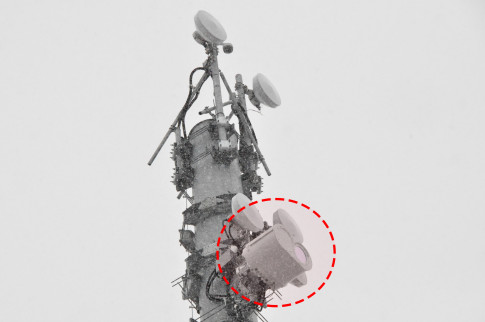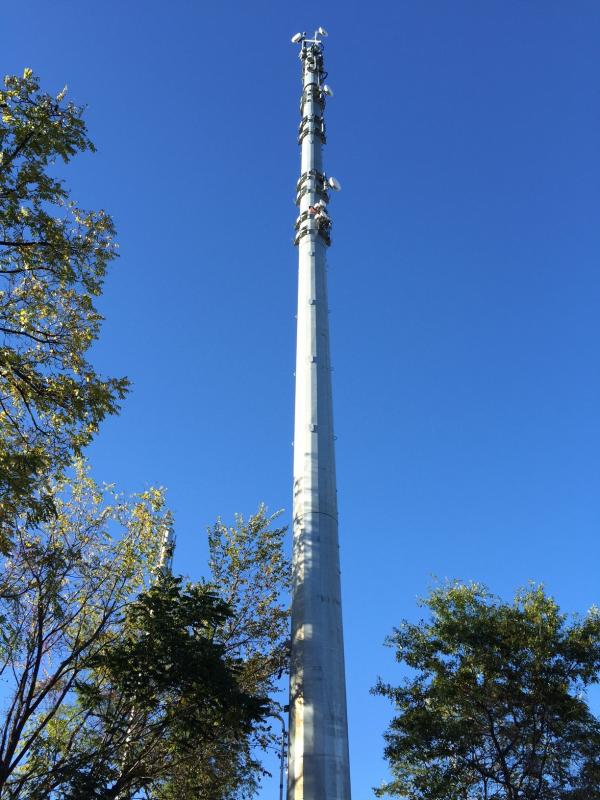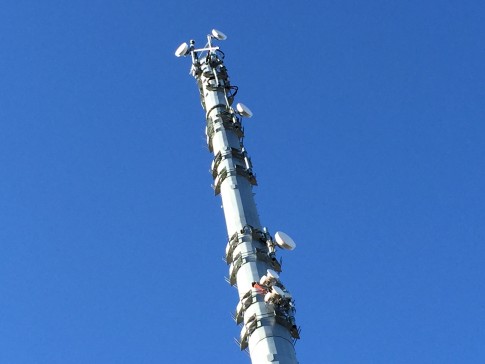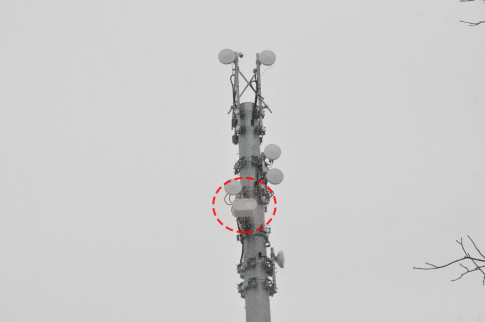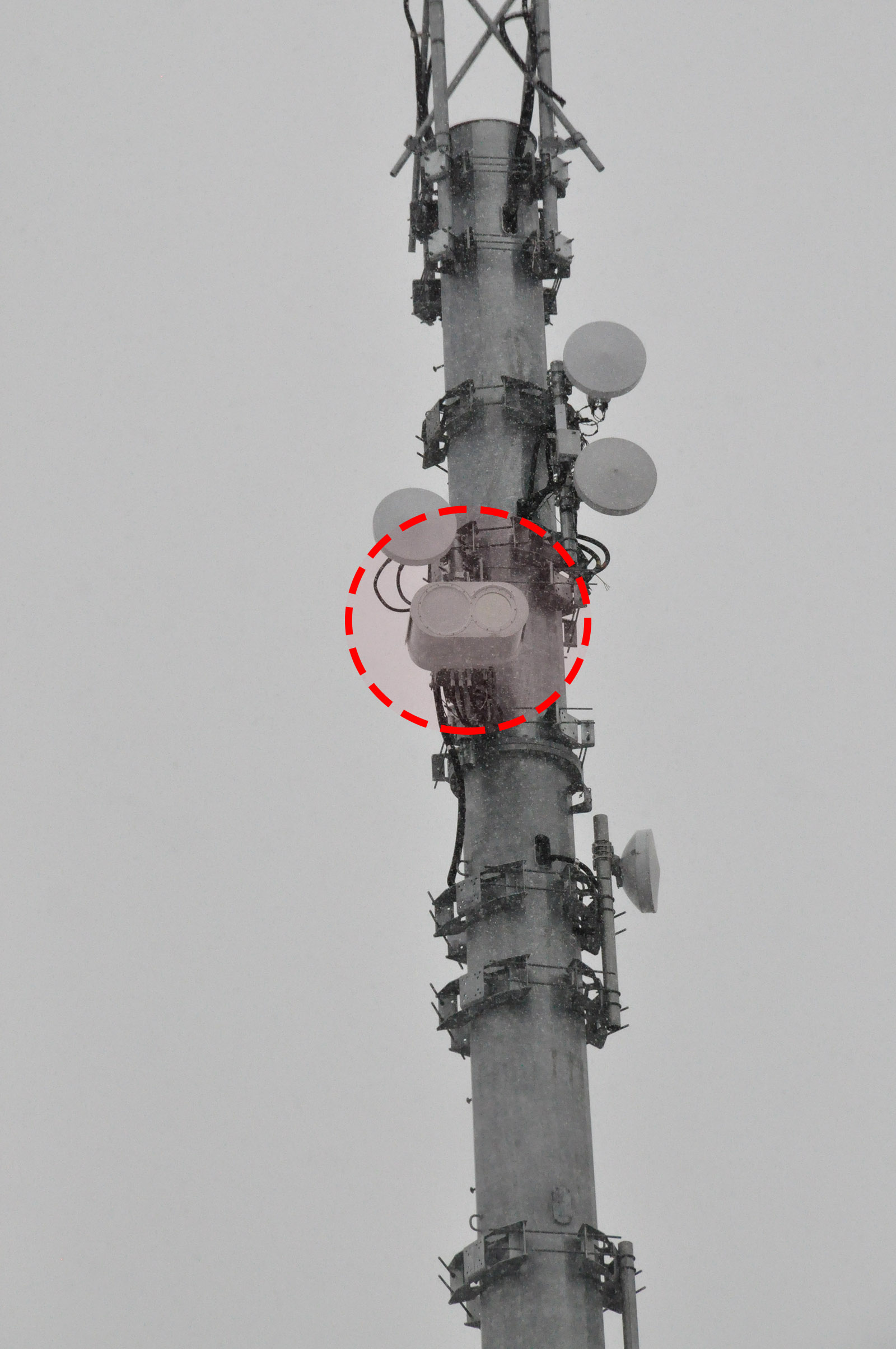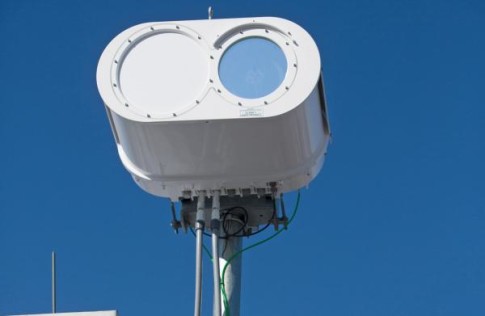Over the past few weeks, a new piece of equipment has been spotted hanging off the NYSE primary microwave tower. Here it is…
– Meanwhile, Over At The “New York” Stock Exchange… Lasers (ZeroHedge, March 1, 2015):
The last time we looked at the most important tower in the world, about 4 months ago, it looked as follows:
The tower in question is the primary microwave relay into the ill-named “New York” Stock Exchange which actually is located just off MacArthur Boulevard and Route 17 in Mahwah, New Jersey, and in our opinion is the “most important tower” in the world, because without it, the financial industry, which these days means a few hundred thousands HFT algos and their math PhD creators, would grind to a halt as suddenly trading would revert back to the “caveman days” of 2007, when one actually traded not just to frontrun a whale order in some dark pool half way around the world, but actually cared about such things as “fundamentals” and “reality” (oh, and there wasn’t some $12 trillion in cental bank created liquidity supporting every asset class).
The reason we bring up said tower, is because over the past several weeks there has been some furious work by engineers hanging off said tower some 100 feet in the air, resolutely adding a particular device to the primary microwave relay tower at the NYSE.
The device in question has been highlighted:
What is said new device? Extremetech explains:
High-frequency trading — the practice of making thousands of algorithmic stock trades per minute — is about to get a big boost in the USA. Anova, a company that specializes in deploying low-latency networks for stock trading, is completing an ultra-high-speed laser network between the New York Stock Exchange (NYSE) and the NASDAQ. The link will be just a few nanoseconds faster than the current microwave and fiber-optic links — but in the world of high-frequency trading (HFT), those nanoseconds could result in millions of dollars in profits for the trading companies. Such is the insanity of the stock markets; such is the unbelievable capacity of HFT to create money out of almost nothing.
If you want to get a signal quickly from point A to point B, you basically have three options: fiber-optic cables, a network of microwave dishes, or laser links. Electrical (copper wire) networks are feasible over short runs, but their reduced functionality and bandwidth over longer runs makes them less desirable than fiber. Microwave (and even higher-frequency millimeter wave) networks also aren’t very high-bandwidth, but because they’re purpose-built, they can take a very direct route, significantly undercutting the latency of an oft-congested and round-about fiber network. Laser networks have all the advantages of microwave/millimeter wave networks, but they have higher bandwidth, and some very clever adaptive optics means they’re not impacted by bad weather. (Microwaves really hate inclement weather.)
Last year, Anova completed a laser network link between the London and Frankfurt stock exchanges, and now, it seems the company is nearing completion on a similar laser network between the NYSE and NASDAQ data centers in Mahwah and Carteret, New Jersey. In the case of both networks, Anova is using equipment provided by AOptix, an American company that is contracted by the US military to produce similar laser-based systems for ground-to-aircraft communications. Each AOptix base station is capable of “carrier-grade” availability (five nines, 99.999%) over a distance of 10 kilometers (6.2 miles). The route, which is about 35 miles as the crow flies and skirts the center of Newark, will probably feature around six or seven base stations, each of which will have a direct line of sight with its two nearest neighbors. The link speed, according to the AOptix tech specs, will be around 2Gbps — not exactly massive by fiber-optic standards, but more than enough for a few thousand trades per second.
The cost of building the network won’t have been cheap — probably a few million dollars — but that’s absolutely pennies for stock traders. (The new fiber link between London and Tokyo, which is also primarily for stock traders, will cost $1.5 billion.)
The exact latency improvement of the NYSE-NASDAQ laser network isn’t yet known, but over a distance of just 35 miles we’re probably talking about nanoseconds. A microwave system currently in place between Chicago and NYC — a straight-line distance of around 800 miles — has a latency of 4.13 milliseconds. Scaling that down to 35 miles (dividing it by 23), you get a latency of 0.18 milliseconds between the NYSE and NASDAQ. I don’t know how fast the existing fiber/microwave links are, but even a difference of a few nanoseconds would be enough to beat out other high-frequency trading companies that are using older, slower networks. Anova, unsurprisingly, says it has dozens of trading firms who want to use the new laser network, all of which could stand to boost their profits. Though, as with all HFT technology, once everyone is using it (or something comparable) profit levels will revert.
And thus the craziness that is high-speed trading continues unabated, faster and more profitable than ever before
And some more from the WSJ:
In 2011, Mr. Persico read an article in a trade journal describing how a Silicon Valley company called AOptix Technologies Inc. had designed military technology using lasers to communicate in battlefield conditions. His first thought: “I wonder if they can put those on a tower?” The technology traced back to the 1990s, when two scientists designed a method to gather images from outer space that corrected for atmospheric distortions. They developed technology for telescopes with flexible mirrors that could adjust thousands of times a second.
Soon, they realized the technology could also be used to transmit data using lasers. They formed AOptix and contracted with the U.S. government to provide communication devices for military aircraft.
Mr. Persico asked AOptix whether its laser system could be used to send stock-market data. The company was confident it could, because stock data would only have to move from one fixed spot to another.
“Finding a tower isn’t hard for us, because we can find airplanes” with the lasers, said the CEO of AOptix, Dean Senner.
Mr. Persico wasn’t the only one who thought of adapting the lasers for stock orders. Several Wall Street firms also reached out to AOptix. After weighing offers, AOptix signed a deal with Anova in December 2012, partly, it says, because Anova had backing from a large Wall Street bank. The bank’s identity couldn’t be learned.
* * *
Some question whether Anova’s lasers will provide a meaningful speed improvement over networks that are already in place, since microwave and millimeter-wave order transmissions also travel at near light speed. “The difference between networks is getting very small in the metro areas,” said Stephane Tyc, co-founder of McKay Brothers LLC, an Oakland, Calif., company that provides fast trading networks. Still, firms such as Anova continue pushing to boost traders’ speeds by increasingly tiny slivers of a second.
High-speed, computerized firms today trade everything from stocks to oil futures to government bonds, including securities whose prices move instantly when the government releases economic data such as jobs reports. To pare precious fractions of a second off the time it takes to transmit such data, Anova and other communications companies place networking equipment at a data center on 1275 K Street in Washington, physically close to government agencies.
In the latest tactic, some high-speed traders obtain news releases directly from distributors, avoiding the tiny time lag involved in going through the financial news media.
“We must think about why this technological arms race is happening and whether it poses any threats to our markets,” said Kara Stein, a commissioner of the Securities and Exchange Commission, in a speech in November. “And we should candidly assess the costs and benefits to both investors and businesses.”
The Treasury Department’s Office of Financial Research in December labeled high-speed trading a “key source of operational risk across all markets.”
* * *
“Speed makes markets way more efficient,” said Peter Nabicht, a former high-speed trader who is now a senior adviser to Modern Markets Initiative, a trade group.
* * *
Mr. Persico set about securing rooftops and other spots to place his lasers between the New Jersey communities housing the NYSE and Nasdaq data centers. Anova said it has dozens of trading firms waiting to try the lasers when they go live. One firm that plans to use the system is XR Trading LLC of Chicago. It is a “very compelling technology,” said XR’s president, Matthew Haraburda. He said if it behaves as intended, it could be “a huge development” in trading technology.
In other words, everyone who splurged on the “brand-new” as recently as 2013 microwave technologies to give their HFT system a leg up… is now obsolete.
Welcome to lasers: where you are either part of the very expensive club, or are being frontrun. Which also means that if Michael Lewis is indeed writing a sequel to Flash Boys focusing on microwave signals and towers as the “next big thing”, he may just want to burn the manuscript. As for what comes next:
Some dream of a replacement for the fiber-optic cables across the Atlantic and Pacific. The idea: Turbocharge intercontinental trading by floating balloons carrying microwave dishes over the ocean.
And that, ladies and gentlemen, is what “trading” has become.
